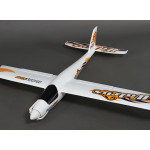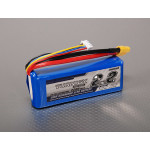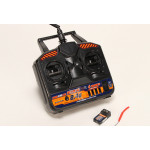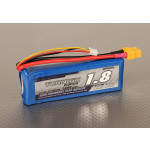
Introduction
Recently during a flying day, I had a tricky flight with a small very fast model in windy conditions, during a turn at the end of the field the wind caught it and I struggled to establish orientation in the poor light so had no choice but to ditch the model.
The plane came down into the next field, a field that was full of tall-growing crops and my flying buddy uttered the immortal line ‘You’re not going to find that mate’. Undeterred we set off to the area we last saw the model before it disappeared behind some trees on the field boundary and I started to use this RSSI trick to home into the model and after 10 minutes of walking we were within 10 feet of it and could hear one of the servos buzzing.
Sadly the model had missed all of the soft landing material and tried to fly through a mature field boundary. This hedge was almost the height of a two-story building and the model has been stripped of its prop, wings, and rear stabilizers leaving what I affectionately now call my Turnigy Lawn Dart.
The EFXtra is a great plane so I will be ordering a replacement.
The reason for this article is that my flying buddy has never seen this method of finding a ‘lost’ model before, despite flying for over 30 years, so I’m documenting it here for all of us pilots in case you have the same situation and need to find that model.
How does it work?
Most modern radios will have the ability to show you the signal strength of the radio receiver in the model. Usually called RSSI (Radio Signal Strength Indicator) it is read in dBm and the higher the number the better the signal. If the model is right by the side of the radio you will read nearly 100, if the model is getting too far away you’ll see the value drop to below 45.
Using this you can see how ‘good’ and strong the signal is from the model you’ve just lost.
The other part of this trick is the fact that those dipole antennas on the top of your radio are not omnidirectional. They have far more sensitivity in one direction.
The reason that we usually fly with the antenna at right angles is due to the fact that the sensitivity of a dipole antenna isn’t great at the tip of the antenna and is best at the sides, radiating outwards.
You can test this easily by placing your model about 20 feet away from you and pointing the end of the antenna directly at it while watching your RSSI signal strength indicator on the radio. You’ll see the numbers drop as you point directly towards it and rise as you point the side of the antenna to the model. This is the principle we can use to find a lost model.
Using it in practice
First of all, you need to find the place on the radio that will show you the RSSI value. Even if you’ve not set it up before on something like a FrSky Taranis you can go into the menu and find the 12/12 menu called TELEMETRY. If you can’t see the sensors in the display (like I have in the image below) simply select ‘Find new Sensors’ from the menu and leave it trying to discover the sensors as you walk towards where you last saw the model.
Don’t worry if you don’t get telemetry right away; if the model is on the ground the radio connection may be obstructed. Keep walking in the general direction and eventually, you will start to see the RSSI value. It’ll probably fade in and out as you get closer; as you walk keep an eye on the values.
Once you’ve got a signal that is reasonably solid then we can start to ‘hone’ into where the model is.
Stand clear of any obstructions and hold the radio at chest height with the antenna as in the image. Slowly rotate and notice the direction you are facing when you get the strongest signal.
Now you’ve got a good idea in what direction the model is from, you start to walk in that direction, stopping periodically to run through the same process to refine the direction as you start to get closer to the model. Make sure that the general trend for the RSSI values is increasing.
On a Taranis, once the values are above 60 then you are starting to get very close.
With these higher values, slow down and do a few 360 degrees turns to make sure you are walking in the right direction for the final steps. Watch the RSSI values increase as you start to get very close and once you have an RSSI reading of more than 80 you should be within 12-20 feet of the model.
In my experience at this point, you can usually hear a servo complaining about the model or you can gently move one of the control surfaces and hear the servo moving to guide you into exactly the right spot.
One thing to remember is that often the model will land in the branches of trees, this is easy to spot in the winter but in summer with heavy canopies of leaves, even a small tree can hide quite a large model. If you can’t find the model in the area with the strongest RSSI reception then look on the floor for any broken parts and sweep the canopy of the nearby trees in case your model is hiding in there too!
Summary
Now, this method only works if the battery is still connected to the model and the receiver is powered after a crash. Writing your name and contact details on a model is a great idea as well as adding GPS units that can report the model's exact location, even if the main flight battery is disconnected.
There are many other gadgets too but this method is a great standby for those models that don’t have a buzzer or anything else to help you find it.
I hope it helps you find your next one. Happy flying and happy finding!
Hear it First: Join our Mailing List
Sign up to receive new product updates, exclusive discounts, news, and more!








